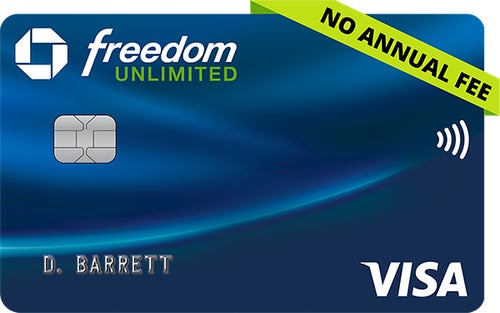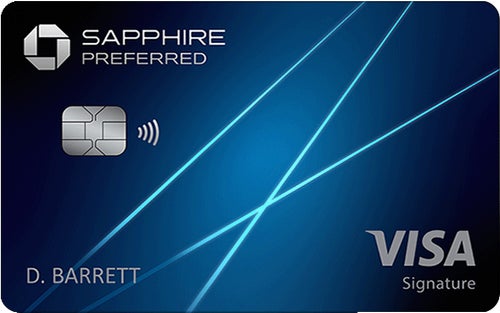Summary
What’s the best credit card to pair with the Chase Sapphire Preferred? In most cases, it’s the Chase Freedom Unlimited. Here’s what you need to know about using these two Chase credit cards to maximize your rewards and save money.
The content on this page is accurate as of the posting date; however, some of our partner offers may have expired. Please review our list of best credit cards, or use our CardMatch™ tool to find cards matched to your needs.
What’s the best credit card to pair with the Chase Sapphire Preferred® Card? In most cases, it’s the Chase Freedom Unlimited®.
By combining an everyday rewards card with a travel credit card, you can maximize the rewards you earn on every purchase. Since Chase allows you to pool your Ultimate Rewards before redeeming them, you can use your Chase Sapphire Preferred to increase the value of your rewards by 25 percent when redeeming them for travel purchases made through Chase Ultimate Rewards.
Why get two Chase rewards cards? The answer is simple. With more than one high-earning Chase credit card in your wallet, you can optimize your rewards and benefits — not only every time you make a purchase but also when you redeem your rewards for travel, statement credits and more.
Here’s what you need to know about pairing the Chase Sapphire Preferred and the Chase Freedom Unlimited.
Chase Sapphire Preferred and Chase Freedom Unlimited
Both the Sapphire Preferred and the Freedom Unlimited are top rewards credit cards, giving you the opportunity to earn top-level rewards on your purchases. While the Sapphire Preferred does charge an annual fee of $95, you won’t end up paying the three-digit annual fee that comes with more exclusive credit cards, such as the Chase Sapphire Reserve®.
In fact, your Chase Freedom Unlimited cash back rewards show up in your account as Chase Ultimate Rewards points, and you can transfer them to your Sapphire Preferred Card. Then, when you use your Sapphire Preferred to book travel through the Ultimate Rewards portal, those points automatically get a 25 percent boost. Rather than the usual 1 cent, each point is worth 1.25 cents.
Chase Sapphire Preferred
The Chase Sapphire Preferred is a travel credit card that offers 5X Ultimate Rewards points on travel purchased through the Chase portal, 2X points on other travel purchases and 1X point on all other purchases. It also gives 3X points on dining, select streaming services and online grocery purchases (excluding Target, Walmart and wholesale clubs). Note: The 5X points on any hotel bookings made through the Chase portal doesn’t kick in until you’ve used up the card’s $50 Anniversary Hotel Credit.
The Chase Sapphire Preferred also comes with two huge advantages that make it stand out from the competition — and well worth the $95 annual fee. First, the Sapphire Preferred is currently offering one of the best sign-up bonuses in the industry, giving new cardholders the opportunity to earn 60,000 bonus Ultimate Rewards points after spending $4,000 in the first three months. That bonus is worth $600 when redeemed for cash back or a statement credit.
Second, your Chase Sapphire Preferred points increase in value by 25 percent when redeemed for travel through Chase Ultimate Rewards — which means those 60,000 bonus points could be worth as much as $750 towards travel.
Chase Freedom Unlimited
The Chase Freedom Unlimited is a cash back credit card with no annual fee that offers 3 percent cash back on dining and drugstore purchases and 1.5 percent cash back on all other purchases. Cardholders can also earn 5 percent cash back on Lyft purchases through March 2025, as well as 5 percent cash back on Chase Ultimate Rewards travel purchases.
Clearly, the Chase Freedom Unlimited brings in high rewards, and that’s before you add its valuable sign-up bonus — an additional 1.5 percent cash back on everything, on up to $20,000 spent in the first year. Essentially, you could earn up to $300 for your sign-up bonus.
When you combine those two sign-up bonuses, you could earn as much as $900 in cash back rewards. Alternatively, if you transfer your welcome bonus from the Freedom Unlimited to the Sapphire Preferred, you could end up with 90,000 points. And since each of those points has the potential to increase in value by 25 percent — depending how you choose to redeem — you could end up with $1,125 in rewards just from the sign-up bonuses of these two cards.
This is why the Chase Freedom Unlimited is one of the best cards to pair with the Sapphire Preferred.
How to start pairing Chase cards
If you don’t already have one or both of these credit cards in your wallet, we recommend starting with the Chase Freedom Unlimited. Why? Because it’s an everyday, all-purpose rewards credit card, you’ll be able to earn high cash back rewards on your regular purchases right away. Plus, you don’t have to pay an annual fee for the privilege.
Once you’ve decided that you like your Freedom Unlimited well enough to add a second Chase credit card, it’s time to apply for the Chase Sapphire Preferred. Keep in mind: If you’ve applied for more than five credit cards (by any issuer) in the past 24 months, you probably won’t be accepted for a new Chase credit card due to Chase’s 5/24 rule. However, if you apply for cards sparingly and have a decent credit score, you should be able to secure the Sapphire Preferred.
After you’ve paired your Chase Freedom Unlimited and Chase Sapphire Preferred Card rewards, you might want to consider adding the Chase Freedom Flex℠ to take advantage of the Chase trifecta. With a third Chase credit card at your disposal, your rewards-earning and money-saving opportunities continue to expand — so keep that in mind as you plan your next few credit card applications.
Pairing these cards for best use
If you don’t know how to use these two cards in a way that maximizes your rewards, you could miss out on some money-saving opportunities.
Start by making enough purchases to earn each card’s sign-up bonus. That’s $4,000 in purchases on the Sapphire Preferred. It may sound steep, so we recommend using your card for everything you spend on in the first three months — utilities, cellphone bill, auto insurance and more.
Once you’ve achieved that spending goal, you should switch most of your everyday purchases like groceries, drugstore purchases, online shopping orders and gas to your Freedom Unlimited since the card’s welcome offer of an extra 1.5 percent cash back on everything applies to up to $20,000 in the first year. This is on top of the normal 1.5 percent cash back on all general purchases.
After the first year, you can use each card for the purchases that earn the highest rewards. Since the Chase Freedom Unlimited earns more rewards per dollar on all purchases except travel, it makes sense to use this card for most of your non-travel spending. You can save on your travel, streaming subscriptions and online grocery orders with your Chase Sapphire Preferred.
You can maximize the benefits of both cards by following the quick guide below:
 |  | |
|---|---|---|
| Spending categories | Use for dining, drugstores, Lyft rides and general purchases | Use for travel purchased through the Chase portal, general travel, select streaming services and online grocery purchases |
| Sign-up bonus | Earn an additional 1.5% cash back on everything you buy (on up to $20,000 spent in first year) | Earn 60,000 bonus points after spending $4,000 in the first three months |
| How to maximize rewards | Transfer cash back rewards to Ultimate Rewards points at a rate of 1 cent per point, then combine with Chase Sapphire Preferred points | Redeem points for travel through Chase Ultimate Rewards to increase their value by 25% |
Bottom line
Pairing the Chase Sapphire Preferred with the Chase Freedom Unlimited is a good option for most people who want to get into pairing reward cards. You’ll be able to take advantage of the Freedom Unlimited’s high cash back potential while increasing the value of your rewards by 25 percent if you pool your points onto the Chase Sapphire Preferred. Add in two of the best sign-up bonuses on the market, and you have the potential to get a lot of value out of your new Chase credit cards.
Editorial Disclaimer
The editorial content on this page is based solely on the objective assessment of our writers and is not driven by advertising dollars. It has not been provided or commissioned by the credit card issuers. However, we may receive compensation when you click on links to products from our partners.





